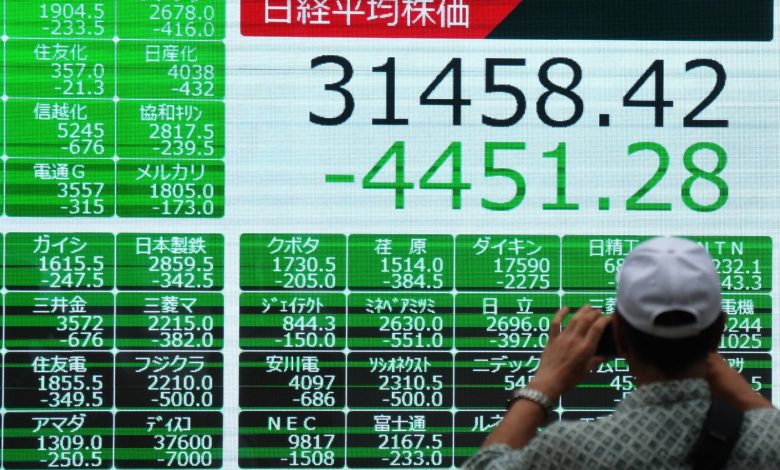Japan’s Nikkei suffers biggest rout since 1987 Black Monday

Japanese stocks plummeted on Monday in their largest single-day decline since the Black Monday crash of 1987, fueled by last week’s global stock market downturn, economic worries and concerns that investments funded by a low-cost yen were being liquidated.
The Nikkei share average shed a staggering 12.4% as Friday’s dismal jobs data heightened worries of a possible recession and as the yen rallied to seven-month highs versus the dollar.
At its lowest, the Nikkei plunged as much as 13.4% on Monday. Its biggest single-day rout was a drop of 3,836 points, or 14.9%, on the day dubbed “Black Monday” in October 1987.
It suffered an 11.4% drop in October 2008 during the global financial crisis and fell 10.6% in the aftermath of a massive earthquake and nuclear meltdowns in northeastern Japan in March 2011.
Japan’s banking stocks led the rout, which pushed the Nikkei into bear market territory, given its 27% drop from a July 11 peak of 42,426.77.
From July 11 to Monday’s close of 31,458.42, Nikkei has wiped out 113 trillion yen ($792 billion) of that peak market value.
“The rapid move in the yen is putting downward pressure on Japanese equities, but it’s also driving an unwind of a major carry trade – investors had leveraged up by borrowing in yen to buy other assets, chiefly U.S. tech stocks,” said Kyle Rodda, a senior financial market analyst at Capital.com in Melbourne.
“We are basically seeing a mass deleveraging as investors sell assets to fund their losses.”
The Nikkei lost 4,451.28 points on Monday, its biggest ever one-day drop in point terms, eclipsing the 3,836.48 points it lost on Oct. 20, 1987, when the Black Monday global stock market crash hit Japanese markets.
Japanese Finance Minister Shunichi Suzuki said the government was monitoring markets with “grave concern.”
“It’s hard to say what is behind the decline in stocks,” Suzuki told reporters.
Most analysts said neither interest rate expectations nor economic data could explain the severity of the sell-off, although it was possibly driven by the rise in the yen whose near-zero short-term yields and steady depreciation had made it the funding currency for billions of dollars worth of investments for years.
The yen was last up 2.5% at 142.96 per dollar and has risen 14% in less than a month, driven in part by the Bank of Japan’s interest rate rise last week and an unwinding of yen-funded carry trades.
“In short, not only the currency but the entire ‘value’ trade in Japan which had hijacked our market for two years is being unwound,” said Richard Kaye, a portfolio manager at Comgest in Tokyo.
Global selloff
U.S. stocks sold off for a second straight session on Friday, and the Nasdaq Composite index confirmed it was in correction territory after the jobs report stoked fears of a recession and expectations for a big Federal Reserve (Fed) rate cut in September.
U.S. stock futures were sharply lower on Monday in a sign Wall Street shares were set for a fresh selloff.
“I think the U.S. economic slowdown worries were too much, but the market did turn nervous after the Bank of Japan’s rate hike as they thought the domestic economy is not strong enough to justify the rate hike,” said Tomochika Kitaoka, chief equity strategist at Nomura Securities.
The banking sector slumped 17% to become the worst sector among the Tokyo Stock Exchange’s 33 industry sub-indexes.
Chip equipment maker Tokyo Electron fell 18.48% and was the biggest drag on the Nikkei. Uniqlo brand owner Fast Retailing lost 9.59% and technology investor SoftBank Group sank 18.66%.
The broader Topix fell 12.2% to 2,227.15, its weakest since mid-October and also moved into bear territory as it clocked a 25% decline from its July 11 peak.






